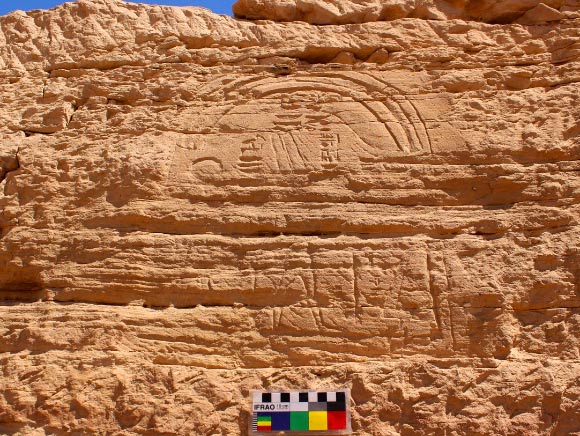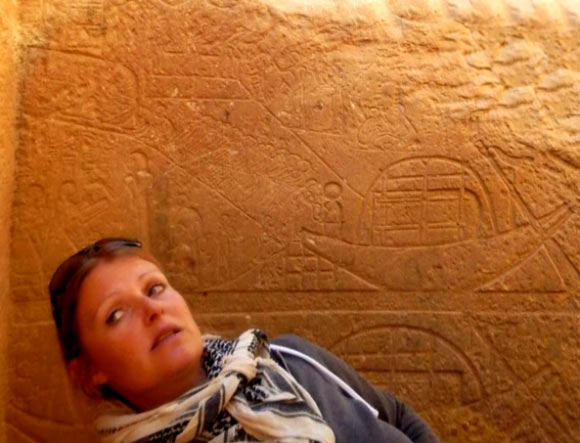A unique 2,500-year-old wall relief showing an unidentified pharaoh and two deities, a rare depiction of obelisks being cut and loaded onto boats, and two large sandstone obelisks have been discovered within the ancient quarry of Gebel el Silsila, 65 km north of Aswan, by archaeologists from the Gebel el Silsila Survey Project.

2,500-year-old stone carving at the Gebel el Silsila quarry depicts a pharaoh and two deities. Image credit: Gebel el Silsila Survey Project.
The ancient wall relief (46 x 38.5 cm in size) shows an unidentified Egyptian pharaoh presenting offerings to the gods Amun-Ra and Thoth, a unique combination rarely depicted as a pair. The combination of the pair may be due to a lunar aspect of the cult at Gebel el Silsila.
“What is unique about the relief is that it shows the gods Amun-Ra and Toth together. These two deities are rarely represented together,” said Dr Maria Nilsson of Lund University in Sweden, director of the Gebel el Silsila Survey Project.
“We believe that the combination is related to a connection with the moon. Our research indicates the existence of a previously unexamined moon cult.”
“All three figures are poorly preserved, but some details can be made out, including the characteristic double feather crown of Amun-Ra, and the moon disc of the ibis-headed Thoth. The item presented by the pharaoh is no longer discernible.”
The readable inscriptions are merely titles of the gods: ‘Amun-Ra, King of the Gods, Lord of [-],’ and ‘Thoth, Twice Great, Lord of [-].’
Just below the winged solar disc the text reads: ‘Lord of the Two Lands, Behedet (Horus of Edfu).’
The personal text of the pharaoh is limited to ‘Lord of the Two Lands’ followed by a cartouche and short epithet. The royal titles and the cartouche are poorly preserved.

Dr Maria Nilsson near the depiction of Egyptian boats with sandstone blocks. Image credit: Gebel el Silsila Survey Project.
“The preliminary study suggests a later dynastic date, presumably para or post Third Intermediate Period (1069-664 BC),” the scientists said.
The team also found two large sandstone blocks, abandoned in their original location due to cracks that appeared during the stone-cutting process.
Archaeologists were familiar with the famous obelisks in the Aswan quarry, but Dr Nilsson and her colleagues have now found two more.
Among the new finds is a rare depiction found inside the famous monument of the Speos of Horemheb. It shows two obelisks being cut and loaded onto boats.
“What is spectacular about this find is that the scene is visible through a second scene which was engraved on top of it, and through stylistic comparisons we believe the underlying scene, showing a boat transporting obelisks, to be from the early 18th dynasty, possibly from the time of the famous female pharaoh Hatshepsut,” Dr Nilsson explained.







